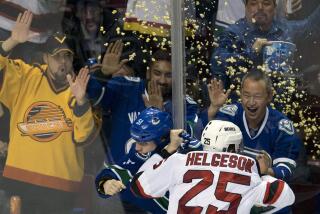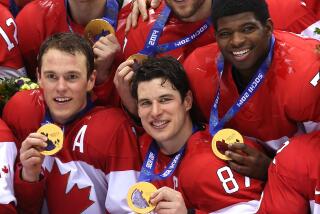Today’s Players May Have Outgrown the NHL Rinks
- Share via
NEW YORK — Mark Messier says the evolution of NHL players has rendered the league’s rinks obsolete.
“The NHL doesn’t have any choice but to go to a bigger ice surface, and I feel the sooner the better,” the Edmonton Oilers center said during the recent Canada Cup final against the Soviet Union. “The game is just too fast now, and the players are too big.
“It’s like a pinball game out there. You’d see a lot better hockey on a bigger rink, and the fans would enjoy it more. There would be more of the skill-control game. Players are getting hurt too often on the small ice surface.”
Athletes in all sports are more physically imposing than they were 20 years ago, but few changes in dimensions of playing areas have been made to accommodate the difference.
The baseball diamond remains constant, although the height of the pitcher’s mound and the depth of the outfield fences have been adjusted through the years. The NBA basket has remained at 10 feet, despite the ever-soaring heights and leaping abilities of players. The size of the NFL field has remained unchanged despite the ever-increasingly violent nature of the collisions that take place on it.
“Everything has changed except the ice,” Messier said of the NHL. “The equipment is better and the game’s faster. The style of the game has changed. It (a bigger surface) would be the best thing to happen to the game in a long time.”
The biggest drawback, from management’s viewpoint, involves economics. Increased rink size would eliminate the first few rows of seats surrounding the boards, an automatic reduction of revenue. Furthermore, ticket sales are related to the nature of the NHL game, which relies in part on violence for fan appeal.
The only elements of the game that draw as much fan reaction as goals are hard checks and fights. The league has been slow to institute measures to curb fighting; why should it want to reduce collisions?
“I think you see better hockey on smaller rinks,” Boston Bruins General Manager Harry Sinden said. “You see more contact. A lot more. You see a lot more goalmouth action and not nearly as much open-ice play, which creates a different game.”
The Bruins skate on one of the three “small” rinks in the NHL. The ice in Boston Garden is seven feet shorter and two feet narrower than “regulation.” All NHL rinks other than Boston, Buffalo and Chicago, are 200 feet by 85 feet. Maximum for European rinks is the same 200 feet long but 15 feet wider.
On larger surfaces, Europeans have developed a style that relies on skating and passing skills more than hitting and intimidation.
“In my opinion, NHL fans would be bored to death by Christmas,” Sinden said of watching games on larger rinks. “Having gone over there (Europe) and watched a number of games, that’s exactly what happened to me. Occasionally, if the Soviets are playing, you’ll see a hell of a game, but to try to watch that kind of hockey for two weeks, you’d be bored to death.”
Bob Clarke, who has played and now is general manager for the Philadelphia Flyers, agrees with Sinden. As a player, Clarke made a living mucking in the corners.
“If you’ve ever watched European hockey, it’s boring hockey,” Clarke said. “Nothing happens. There’s very few shots on net, and there’s a lot of fooling around in midzones.
“My feeling is that we could make the midzones smaller and bring the goal line out farther and not have offsides for a two-line pass. That might open it up some.”
Said Buffalo Sabres Coach Ted Sator: “If you’re looking at technical improvement of the game, the skilled players are going to benefit from bigger surfaces. As it is now, the clutching and holding up away from the play is here to stay, because it’s the only way to slow down a great offensive player.
“But it’s an economic issue, as well. Looking at attendance figures, it would come down to the (management) attitude that ‘Well, it don’t look broke to me, so don’t fix it.’
“You can’t put the fans into one category, either,” Sator continued. “Some people like the artists, and some like the guys who mix the paint. I think a good hockey game has all those elements.”
More to Read
Go beyond the scoreboard
Get the latest on L.A.'s teams in the daily Sports Report newsletter.
You may occasionally receive promotional content from the Los Angeles Times.






